Once upon a time, just past Spring Equinox, the people were struggling to cope with a new disease never seen before. As coffee houses, restaurants and gyms closed, the people began getting outside, into the woods to walk. They began to remember that nature was once their source of nourishment and exercise. They wondered if this disease might bring a big change. Perhaps it would bring them back into closer relationship with nature, might heal their sense of separation, and restore their connection to their wild kin. With few cars on the road a quiet descended that some of the people had never heard before. Birds were singing that they never heard before. Spring birdsong filled the forest.
Ah, the forest. This was a disease that destroyed lungs.The elders pleaded with the people to remember that breathing the breath of the trees would heal them. As pollution abated, the air became clear, and the people remembered that the forests are the Earth’s lungs. But in cities big and cities small the sudden onslaught of people to the outdoors was too much of a good thing. Droves of people suddenly swarmed into the lush green hills and woods, making social distancing impossible, and the parks and trails were closed. The people returned to social media as they, for everyone’s sake, moved back indoors. Would they forget that the change they glimpsed is possible? . . .
Here in North Carolina spring is unfolding gorgeously, as if nothing is amiss. The elderberries are leafing out, and the blueberries are flowering as they always do. The ephemeral wildflowers are blooming their hearts out, as if people are not in the midst of such suffering. The dogwoods and redbuds are opening their profusion of blossoms, ever such a sign of hope. Sadly, people are confined to their homes. When nature could be bringing us much healing we are too sick to receive it.
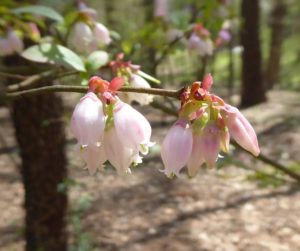
Normally, friends and family would be gathering for visits and small ceremonies here in our forest garden, soaking up the warmth and beauty. But this is not a normal spring, for people, at least. The bluebird houses are full of eggs, but the chairs on the lawn are empty, because my age group is the most vulnerable. To help “flatten the curve” no one is leaving the house unless they absolutely have to. I go out in the woods and garden as often as I can to witness this vernal emergence in the warming sunlight, perhaps not wanting to miss it, should I not live to see another precious spring.
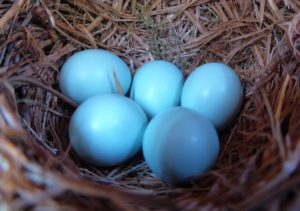
Longing to share this exuberant flourishing, I want to tell you the story of our relationship with this small piece of Earth on which we are planted, to use Sharon Blackie’s lovely phrase. It is the story of the restoration of this little piece of woodland and our hopeful efforts to create connection with larger wild lands, for the sake of the animals and plants that need forests to thrive. I tell it to add my voice to an emerging, powerful prayer that something will arise from this pandemic that will restore the people of the world to right relationship with and joyous reconnection to nature.
Restoring the ecology of an altered landscape to its integrity, to its original harmony, is a form of resacralizing the Earth. Whether it’s a large contiguous forest or a small suburban sliver of woods, like ours, restoration is an act of love. Ecologists like E.O. Wilson in his Half-Earth Project are telling us that it is imperative that we protect the large forests that remain and that we create connectivity between large wild lands. Others, like Doug Tallamy in his book Nature’s Best Hope are saying that it is necessary that we link these large forests with our small gardens if we hope to retain the vitality and biodiversity of our native plant life and adequate corridors for the migration and survival of our wild animal species in the midst of rapid development.
While restoring and reconnecting the land, we are restoring and reconnecting ourselves to the land. Hopefully, in rebuilding the relationships of species, we can also recover something of the respectful human-earth relationship once had by the people who lived for thousands of years on this land, as part of the land. By caring for the land, perhaps we can make amends to the original ancestors of place that were displaced. Here, these were the Siouan speaking Saponi and Occaneechi peoples, now the honored Occaneechi Band of the Saponi Nation. I also hope to bring some measure of healing to the souls of my own ancestors of blood who lost the beloved homelands to which they were once indigenous.
When we moved to semi-rural Chapel Hill North Carolina from the urban San Francisco Bay Area an acre lot seemed huge to us! I was intrigued by the small fern-filled wetland along the creek called Buck Branch that ran through the small woods. Looking at a map of the area, I noticed that “branch” is the name given to all ephemeral streams. I loved to imagine making my way along this branch to where it connected with Morgan Creek, continuing on to the larger New Hope River, and finally to the great Cape Fear, where it opens to the ocean. I followed the winding contours, reconnecting the secret hills and valleys of the land, bypassing altogether the roads that divide and bisect the land so unnaturally.
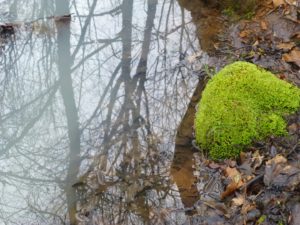
The small woodland was populated with huge loblolly pines. There were also a few large hardwoods. These were moored like great masts with Chinese wisteria vines as big as my thigh. Once, when we had to cut a tree, we took a photo of my husband and son holding it up with the tips of their fingers. Of course it was really held up by the vines. A sleepy screech owl sat in the tangle of vines as if still unseen. Any smaller trees that had tried to grow up were girdled and twisted, suppressed by the wisteria. As we removed the wisteria there was no understory left at all.
Here and there we found barbed wire incorporated into the trunks of those few remaining hardwoods. This told us the story of the use of the land: It had been a bottomland hardwood forest along the creek. Then it was cut down and converted into pasture for cows, hence the barbed wire. I never met the farmer, Mr. Shiedle, but when I visited his wife she showed me an amazing collection of beautiful wooden plaques and sculptures that her late husband had carved. Perhaps this was his way of honoring those trees.
When the pasture was abandoned it grew up in loblolly pines. In the southeastern forest these are the first trees to grow back, because pines can germinate and grow in sunlight. As the pines grew tall they provided shade, which is what hardwoods need in order to germinate. A few sweet gums, tulip poplars and persimmons, all early succession trees, had gotten a chance to grow up by the time the wisteria arrived. We had begun removing the wisteria at the back of the property and were almost up to the road when Hurricane Fran roared inland. We spent a terrifying night hearing the crack and thunder as each huge pine slammed to the ground. The morning revealed thirty great pines down. Only two remained, one on our land and one on the neighbor’s across the creek.
I don’t remember how soon I was able to view the hurricane as an opportunity rather than a disaster. But now, with the wisteria and pines mostly gone, the land was free to continue its natural succession back to bottomland forest. We embarked on a project of trying to help restore the land to the species of plants and trees that would have or might have populated the original wetland woods. All my life, wherever I have lived, I have been eager to learn all the plants and trees and animals of the various local habitats. Meeting the inhabitants of the land has always been my way of making each place feel like home, of feeling rooted there. As luck would have it, when we moved to Chapel Hill we found ourselves living near the NC Botanical Garden, which is dedicated to the conservation of native plants. I became a tour guide at the garden so that I could learn about and teach visitors what grows in this native landscape. Now I had the opportunity to make use of what I learned!
Over the years we rescued from burgeoning development many species of plants to bring home to our small forest. We saved fifteen or so beech trees and lots of Christmas ferns when the highway around Chapel Hill was widened from two lanes to four. When the Durham Museum of Life and Science converted their native plant garden into a parking lot we dug and replanted a sample of the whole suite of spring ephemerals that grow in bottomland forests of the piedmont. These have thrived and spread and now clothe the entire forest floor. When land was cleared for housing developments we saved other small trees, shrubs, ferns and wildflowers in an effort to restore not only individual species but also the ecological relationships that comprise a fully functioning creekside habitat. Rather, we try, knowing that we can never know the myriad intricacies of the plethora of interactions that make a forest.
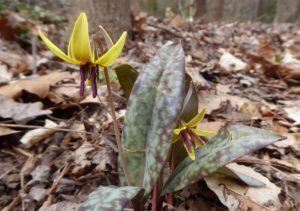
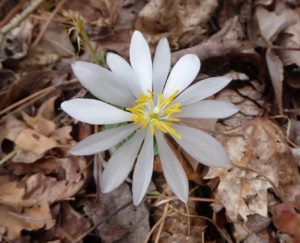
With the pressure of urbanization, however, came the deer, moving through the forest on their newly established routes and eating everything, so it became a continuous process of replacing the replacements! I wouldn’t have it any other way, because with each planting comes a greater intimacy with the land. With every excuse to be in the forest digging the rich bottomland soil there is a sense of immersion in wildness. I plant in the wild by day and dream of the wild at night. Ever so gradually the forest is recovering. As it heals, I, too, heal from the painful sense of separation from nature that our Western culture teaches.
Hand in hand with restorative planting comes removing the invasive species (like Chinese wisteria, English Ivy, and Japanese stilt grass) that arrived here without any of the natural predators of their homeland to keep them in check, so they proliferate and choke out native woodland species. The natives are disadvantaged by having evolved with natural predators to keep them in check, in balance with each other.
Each passing human generation doesn’t realize what’s missing from what seems to be just a normal, rather flowerless and silent forest. Studies reveal that there are 50% fewer birds than in 1970. Children taken on walks today don’t know that the forest floor (when natural lightning fires kept the forest more open) used to be covered with wildflowers. Maybe their parents remember that there used to be a few more flowers and birds, but you’d have to talk to great-grandparents and beyond to gain a sense of the abundance of wildflowers and birds that once graced the land. As native understory flowers and shrubs disappear from natural areas, any families who remove invasive plants and restore natives to their gardens are making sanctuary, refugia, for the threatened biodiversity of plants and animals to continue to thrive. These garden sanctuaries become vital links in a chain of reconnected lands.
It makes sense that Chorus Frogs and Spotted Salamanders, Barred Owls and Box Turtles call these wetlands home. But what do these forest trees have to do with preserving the biodiversity of other birds and butterflies? Almost everything. Most birds, even if the adults are seed-eaters, need to procure insects to feed their growing babies. Those bluebirds will soon need lots of them! Much of this insect food is in the form of caterpillars, the caterpillars of some of our most beautiful moths and butterflies. These caterpillars nourish themselves on the leaves of specific native plants and trees.
Our beautiful Eastern Tiger Swallowtails’ caterpillars need to eat the leaves of wild cherry trees and tulip poplars. The caterpillars of our gorgeous Zebra Swallowtails feed only on the leaves of pawpaws, those quintessential small trees of streams and wetlands. The host plants of Luna Moths are the persimmons, sweet gums, hickories, and black walnuts, all trees of the bottomland forest. The roots of the hardwood trees interlace and form a matrix that hold each other up against wind, hold the soil of the slopes above creeks against erosion, and absorb extra rainwater against flooding, thus cleaning and preserving the creeks themselves for the neighbors downstream.
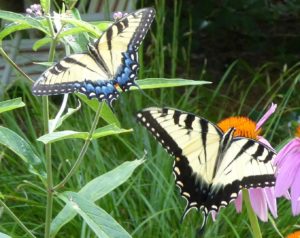
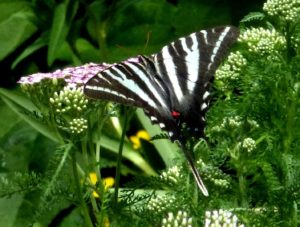
I used to feel vaguely ashamed that this restoration project was just a pleasurable, but lonely, isolated undertaking, a naval-gazing sort of thing. Biologists criticize and lament these little islands left in fragmented forest. Weren’t we creating a little inconsequential island within an otherwise fragmented, agricultured, pastured, lawned, or paved landscape? But with climate change becoming critical as more forests are lost to development, people are realizing that saving any remaining forested land is important.
There is a growing momentum to create connectivity, conserving corridors for the movement of animals between these remnant forests. We don’t have to feel helpless, as if our puny little efforts to foster native trees or wildflowers don’t amount to much in saving species. Our woods and gardens are potentially powerful links in a chain of connection, rather of reconnection in space and time, that allows birds, butterflies, and other animals to move across the land to find food, to mate, to migrate.
It’s late March. I walk the forest path observing that while the trout lilies and bloodroots are finished blooming, their seedpods are enlarging; the toothworts and windflowers and Dutchmen’s breeches are still blooming. The big umbrella leaves of Mayapples are unfolding, and, like trout lilies, the ones with two leaves are beginning to form flower buds. Solomon’s seals and Virginia bluebells, what I think of as the second wave, are already in bud and bloom. The various kinds of ferns are unfurling their fiddleheads. Today I notice Jack-in-the-pulpit leaves starting to emerge from the warming soil. The yellow flowers of spicebush are having their day to shine.
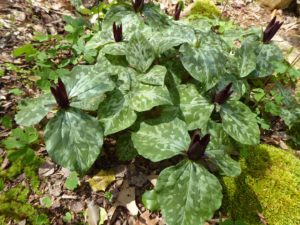
I am fascinated by all the intricate forms of plant-animal interaction. What is responsible for the amazing increase and spread of these rescued wildflowers? Ants. Myrmecochory is the word for it. It’s from the Greek, meaning “circular dance.” Attached to the seeds of the spring ephemerals, including Dutchman’s breeches, bloodroots, trilliums, hepatica, also violets and wild ginger, are little food bodies called elaiosomes that are rich in lipids, amino acids, and other nutrients. These are very attractive to ants when it is still too cold for them to find other foods to eat.
Evolutionarily it seems that these plants have encouraged ants to disperse their seeds by attaching these little nutritious appendages to lure ants to them. The ants carry the seeds back to their nest, feed the little fat body to their young, and discard the rest of the viable seeds in their fertile trash heap. This gives the seeds a good environment in which to germinate. I like to picture each little ant making their circle dance from seed pod to nest, back to seed pod again. Gauging from the exuberant spread of these wildflowers, thousands upon thousands of ants are reveling in dancing this rite of spring!
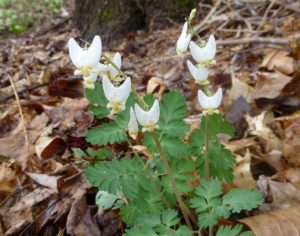
Ten years ago, as we continued to plant more plants and discover more animals arriving, I began to keep an Inventory. There are now over 300 species of native trees, shrubs, ferns, vines, wildflowers and mosses. We have observed over 200 species of fauna including foxes, lizards, salamanders, frogs, turtles, insects, birds, and butterflies. This is truly an animate form of “build it and they will come!” I enjoy using this inventory to learn about and keep records of the various interrelationships. Today this forest garden is certified as wildlife habitat by the National Wildlife Federation, as high quality bird habitat by Audubon, and as a native plant conservation garden by the North Carolina Native Plant Society. All woods and gardens, even small ones, planted with native species can contribute to the important effort to restore and connect.
We are learning that forests themselves are all about connection. The fungal networks, called mycelium, partner with tree roots to transport water up from the soil and move nutrients down from sunlight to feed not only individual trees, but also for mother trees to feed their offspring. Sometimes mother trees even feed trees of other species. Every day, researchers learn more about the extent of compassion spread throughout this “wood-wide web.” We can join in and support this compassionate connectivity.
In Japan scientists have been studying the health benefits of what is called “forest bathing.” Many articles have been written about the gains to be had by breathing the medicinal aerosols emitted by trees. It is ironic that Covid-19 is a lung disease, and we are forced indoors by it, when breathing forest air, whether walking in parks or gardening, is just what the doctors were beginning to prescribe for mental and physical health. Now, with less pollution in the air, imagine trees, the great lungs of the Earth, breathing huge, vigorous, freed-up, out-breaths to all creatures. Let’s all pause to take a big breath of that fresh air, with gratitude to the trees.
Writers remind us that restoring must include restorying the land. When I have been quiet enough to listen, the land has told me many stories. Hazelnut and Turtle have told tales that have opened me to the unseen world that is present in the midst of this seen one. Hazelnut Tree told a story called Hazelnut Wisdom about the compassion of the Spirit-filled Earth with such wisdom and humor it made me cry. Box Turtle told a group of us the story of our inter-connectedness with all of Life called Turtle Teachings. What is the story that this forest is telling me now? That when she is loved and cared for she loves back in wildflowers and bluebirds. She says, “I breathe that you can breathe. My healthy lungs are your healthy lungs. Let us breathe together the breath of Love.”
Walking in the woods in silence, without social or mental chatter, we can practice compassionate presence, opening our senses to awareness of the life around us. When I walk the forest path, I try to remember to walk in a sacred manner, that is, with an awareness of myself as a sacred being, my feet in contact with the sacred Earth. I also try to be mindful of my own goodness of heart in the midst of the goodness of these plants and animals and the spirit-filled land, so that inner and outer goodness can resonate, like attracting like. In this magnetic resonance between human and other-than-human kin the whispered stories can be heard. When I’m being especially aware as I walk, I feel the presence of the ancestors of this place who love the land and my own loving ancestors walking with me and with all the interconnected beings of this land. May we be restored to health. May the Earth be restored to health. May we be restored to the Earth.
Text and photos (C) 2020 Betty Lou Chaika.
sharon blessum
Ah, yes indeed, your good reminder that the trees breathe us and we breathe them. Their lifegiving ways to be appreciated more than ever as lungs are challenged and we are forced to our knees in humility. How did we think we could get along without Nature’s gifts? How did we think we could thrive through controlling rather than receiving.
When we do emerge from seclusion, will we have learned how to live? Finally?
Betty Lou Chaika
Sharon, your last three lines sound like a poem to me and have brought tears. Oh, I so hope that this virus will humble us to know that Nature is and must be primary, humans secondary. Our arrogance in thinking that only humans matter, and we can throw nature aside to acquire whatever we want, is so shameful and foolhardy. Human health and Earth health must be realized as one. Yes, will we learn to live within nature with gratitude, respect, and humility?
RD
excellent account BL. just curious, when did you move to CH and when did you purchase the property you describe? thanks, RD
Betty Lou Chaika
RD, we moved to this acre in Chapel Hill from California in 1987. Glad you enjoyed the accounting, and I know you must be one who is out enjoying this spring!
Diane Winger
Thank you for your lovely & insightful story and for sharing the restoration journey of your sacred land.
Gratefully,
Diane
Betty Lou Chaika
Diane, you’re very welcome, and thank you for naming this sacred restoration work a journey and coming along on it with us!
Suz Robinson
As we walk into the woods of spring the gentle smells of renewal and restoration welcome us. Sending immense gratitude to you, Betty Lou, for sharing this sacredness which nourishes our souls.
Love,
Suz
Betty Lou Chaika
Yes, Suz, spring is the time of renewal in nature. I wish for a time of great renewal in our human-Earth relationship. As nature restores her relationship with the Sun, let us restore our deepest sense of her sacredness. I give thanks, Suz, for sensitive souls like you who are holders and carriers of the knowledge of the sacredness of Spirit-filled Earth.
ann loomis
Such a timely and helpful reminder, Betty Lou. Instead of “Trust in the Force,” try “Trust in the Forest.” I’ve read that magnolia and mimosa trees are particularly protective, both of which we have in our yard. The budding dogwoods are glorious right now. So much to cherish all around us!
Betty Lou Chaika
Yes, “Trust in the Forest,” I love it! Trees are very much a positive force! I wish governments would make the connection between our health and animals’ health and the presence of vast amounts of healthy forests.
Donell Kerns
A chant/meditation/prayer that I have been saying daily:
May the Earth be Well
May the Earth be Well
May the Earth be Well
May humans wake up to sacred nature
May the insects be well, may the soil be well, may the fish be well, may the waters be well, may the air be well, may all plants and trees be well, may all animals be well.
May all humans who have abundance, take less and give more.
May the Earth be Well
Betty Lou Chaika
Thank you, Donell, for the gift of this chant. It feels very right. I will join you in this prayer, sending Metta to all.
Brian T Stokes
Nature speaks to me
and this piece sings
to where it lives in my Soul
Betty Lou Chaika
Brian, I’m grateful to have a poet-friend like you. Every writer should have one!
Margot Ringenburg
Amen to all that you’ve written here, Betty Lou! Author Ben Goldfarb, in his 2018 book Eager, writes of solastalgia, the emotional distress we feel at witnessing the destruction of beloved homelands. Those of us who live in parts of the world experiencing rapid population growth and development feel such distress daily, as roads are forever widened and lots are clearcut. One effective salve for solastalgia is to follow your example and encourage others to do likewise: restoring ourselves by restoring our own humble parcel of land, however small.
Betty Lou Chaika
Margot, I’m glad someone has named the emotional distress (grief, pain, anxiety) that accompanies the loss of the nature we love. Thanks for the book reference. Working to restore “our own humble parcel of land” doesn’t make the grief and pain go away, I’d say, but it reduces anxiety and adds joy and hope. Knowing that others, like you, are doing the same makes me feel hopeful that birds, butterflies, and other insects are getting nourished. I also appreciate your work of educating others about native plants.
Kathleen Hannan
Dear Betty Lou,
Thank you for this wonderful chronicling of the response of all our relations to your years of love, care and learning in the precious place where, as you said, you are planted. I am inspired and deeply moved. 🙏💜
Betty Lou Chaika
Thanks, Kathleen. Yes, in writing this I desire to inspire turning our helpless hope for the Earth into active hope. Everyone with even a small space to plant a few native pollinator plants can participate in becoming part of the chain of connection for birds and butterflies! Build it and they will come! For selecting native plants for their region folks can click on the Native Plant Finder at the National Wildlife Federation or on Audubon’s very user-friendly site.
Betty Lou Chaika
Folks, if you plant nothing else, plant a blueberry! Audubon says it is, “The ultimate bird-friendly, people-friendly native plant. Blueberries support 286 moth and butterfly species in North America. Birds who love this plant include Northern Mockingbird, Blue Jay, Gray Catbird, Brown Thrasher and Red-bellied Woodpecker.” It also attracts many native bees.
Lise Nau
Thanks, Betty Lou! You have done wonders with your acre…
for my part, I’m adding Showy Goldenrod in a big pot to my sunny terrace-in-the-sky.
Stay well,
Lise
Betty Lou Chaika
Lise, I’m so glad to have met you and that you were able to see the little forest! I’ve been reading that goldenrods support more pollinating insects than just about any other species of perennials. Enjoy watching them!
Sandra Brooks-Mathers
I always learn from you. The depth of your appreciation, knowledge and experience in Nature always inspires me. Your work with your acre has wrought beautiful and amazing and magical and, yes, Nature-all results. Nature in all her forms comes so very close to you, as you have gone closer, deeper and more intimate with her. Your nature-intimacy and understanding help me along my path of growing depth and understanding. Thank you so much, dear Betty Lou.
Betty Lou Chaika
Sandra, thank you so much for your interest in learning and your eagerness to open your heart to all of nature. The one thing I always hope for is to provide inspiration, as we surely need more people to see that reconnecting to nature and helping nature to thrive is possible for everyone to participate in. Yes, as a wonderful gardener yourself, you know that the more care and attention we give, the more nature responds, and the relationship between us deepens.